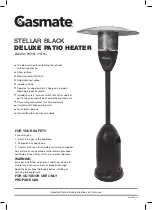
6 720 646 804
8
Appliance details
2.4
Principle of Operation (brief overview of modes)
Fig. 3
1
Air Heat Exchanger
2
Compressor
3
Cooled / Dehumidified Air
4
Upper/Lower Electric element
5
Condensor Coil (heat exchanger)
6
Drain valve
7
Domestic Hot Water outlet
8
Ambient Room Air
9
Fan
10
Cold water supply
System theory
An Electric Heat Pump Water Heater draws heat from
the ambient air and transfers that heat to the water in
the tank. Ambient air inside the room where the water
heater is installed is blown across an evaporator by a
fan. Cold refrigerant inside an expansion valve is heated
from this ambient air. This warmed refrigerant is then
sent through a compressor where it becomes extremely
hot. The hot refrigerant then passes through a
condenser coil that is wrapped around the outside of
the tank. The heat from the hot refrigerant is transferred
to the stored water inside the tank. After transferring it's
heat, the now warm refrigerant is pushed through an
expansion valve where it is cooled and depressurized so
the process can begin again. In addition, the ambient air
is cooled and dehumidified as it passes through the
evaporator and can be used to adjust the climate of the
room.
Built in controls offer a variety of operational modes to
suit every user’s needs. When operating with the heat
pump only (Economic Mode), the water is heated using
only the ambient air. Economic mode does not activate
the electric element inside. This mode may take longer
to heat the water to set temperature but uses less than
1/2 the electricity of a similar size electric tank.
The Auto mode use the electric element to supplement
the heat pump in the event that the water is not reaching
set temperature.
Electric mode allows for the water heater to function as
a standard electric tank without the use of the heat
pump.
Brief overview of modes
• Economic Mode;
• Electric Mode;
• Auto Mode (default mode);
• Vacation Mode.
9
3
7
6
5
2
8
6720646804-01.1V
4
4
1
10









































